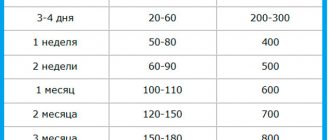A strict and rigorous regime for children is a legacy of our Soviet past, as is the close swaddling of infants, or the habit of protecting, wrapping, protecting from the whole world. When it comes to talking about a child’s daily routine, almost all modern mothers simply smile condescendingly and shrug it off. Why, if the child’s body itself intuitively understands its needs and lets us know about it? This approach is the other extreme, which also cannot be resorted to. A strict daily routine is not suitable for the youngest; let’s be honest, it is practically impossible to achieve even at an older age. But a middle ground must be found.
As for the regime or daily routine of a child who is already more than 2-3 years old, the situation changes here. What comes to the fore is not the simple natural needs of the baby’s body, but social activities, games, learning, and instilling useful and very important good habits. Here it is no longer possible to be too liberal or irresponsible in observing the daily routine. The older the child gets, the more difficult it is to teach him to adhere to the regime, but the more important it becomes for his correct and harmonious development.
Photo: depositphotos.com
The main components of the daily routine of children of different ages
The child’s daily routine should include the following mandatory elements:
- meal time. A child, depending on his age, must eat a certain number of times a day. The intervals between feedings are also important;
- time to sleep. The nervous system of a child, compared to an adult, is at the stage of formation, so exhaustion occurs faster, requiring recovery. Also, a small organism spends more energy on all vital processes than an adult. The need for sleep decreases as the child grows.
- time spent in the fresh air. It may include walking, sleeping, playing;
- time for compulsory educational activities. In a children's group and at home from a toddler age;
- free time. It becomes important when the baby already knows how to do something on his own. At this time, the child himself chooses his type of activity. Free time is important for processing received information and realizing creative abilities.
Games
At two years old, the following games and entertainment will be useful and interesting for the baby:
- role-playing games, including with dolls, sets for different professions;
- games with interactive toys;
- puzzles, sorters, busy boards,
- cubes, pyramids, construction sets with large parts;
- dancing, performing movements to music;
- hide and seek;
- singing.
Are there any disadvantages to the daily routine?
Photo: https://pixabay.com/photos/kids-girls-crying-baby-crying-886587/
The disadvantages of the daily routine, or, more precisely, objections to following a strict daily routine, are as follows:
- kids often get out of their usual routine, disrupting the sequence and timing of events. Their sleep and nutrition are easily disrupted by external factors (weather, physical or mental discomfort, changes in the type and method of feeding);
- children can intuitively follow their needs. This is the basis of the objection to forced obedience to a schedule;
- Strict adherence to the daily routine, ignoring individual living conditions, personality traits and age can lead to rigidity of thinking, inability to adapt to changes in the environment, deprivation of individuality and also to health problems.
Walks
During walks, a two-year-old child must explore the world around him, contact and communicate with peers, recognize natural phenomena, examine objects and analyze the actions of other people, and also be sure to be physically active.
Important! Dress your baby according to the weather so that he does not freeze or sweat. Cancel walks when sick or in bad weather.
A competently and clearly organized daily routine for a two-year-old child will ensure the comfort of the whole family and help them learn discipline. And parents will be able to free up time for personal matters.
How is a daily routine beneficial for a child?
The benefits of a routine are determined by physiological and psychological aspects, which are the basis for creating a daily routine:
- the benefit from the physiological side is the development of conditioned reflexes, with the help of which the body adapts to existing conditions. The child is prepared to perform the necessary tasks and does them without unnecessary stress. Those. energy is saved and distributed evenly for all necessary activities;
- from a psychological point of view , the child’s nervous system needs a stable environment, which, with its predictability, gives a feeling of peace and reliability. This, in turn, creates a favorable background for the child’s development, a deeper understanding of the actions performed and the development of skills.
How to accustom your baby to a routine?
To accustom your child to a routine, you need to follow the following simple recommendations:
- You can start accustoming your child to the regime after discharge from the maternity hospital. A parent needs to plan, first of all, his life, taking into account walks and meals. But be prepared that not everything will go smoothly right away. Most often, children enter the regime by 3 months.
- it is necessary to introduce some new stages gradually during complete health and at the moment of satisfaction from the fulfillment of urgent desires;
- it is necessary to take into account the age of the child, the nature of feeding, the time of year, state of health, personality characteristics;
- strive to maintain the regularity of events and their sequence;
- introduce rituals that prepare the child to perform a particular action. They facilitate the introduction of new components of the regime.
Classes
Activities with a two-year-old child may include:
- drawing with pencils or paints;
- modeling from salt dough or plasticine;
- Reading books;
- simple crafts, such as appliqués;
- cards with different objects or animals;
- sorting cereals and putting them into different containers;
- learning new words with an explanation of their meaning;
- getting help around the house.
Child's daily routine
A child’s daily routine depends primarily on his age.
Up to a year
When starting to talk about the regime of children under 1 year old, it would be correct to separately highlight the newborn period.
A newborn's daily routine consists of alternating periods of feeding and sleeping. Ideally, only hygienic procedures are wedged between them: washing, bathing, dressing.
Natural feeding
Natural feeding occurs at the request of the baby. This is important because the baby and mother adapt to each other during this period.
Photo: https://www.pexels.com/ru-ru/photo/3279208/
There are important points:
- It is impossible to limit the time spent at the baby’s breast, because The pace of sucking in babies is different and in the case of a slow “suckling”, with a reduction in feeding time, there is a risk of depriving him of his portion of “hind” milk, rich in protein and lactase. The result is weight loss, abdominal cramps, foamy stools with all the ensuing consequences. The average feeding time is 30-40 minutes (in hot climates, the baby can reduce the feeding time himself, consuming only foremilk, rich in water, and thus quenching his thirst). Valuable hind milk is produced approximately 20 minutes into feeding;
The mother should pay attention to the baby’s correct latching of the nipple so that during prolonged feeding the breast is not injured. Also, there is no need to dry out the skin of the areola with excessive washing and various antiseptics, because... This contributes to the formation of cracks and infection.
- Feeding by the hour during breastfeeding is a thing of the Soviet past, but you should pay attention to a baby that sleeps “too” well. It is advisable that regular sleep breaks between feedings should not exceed three hours. This is very important in the first month, because... Frequent feeding every 2-3 hours contributes to the good development of lactation in the mother, which, in turn, ensures the growth and development of the child and the prevention of mastitis in nursing mothers.
Night feedings must be mandatory, because... they stimulate the production of prolactin, which, in turn, supports daily lactation.
Therefore, if necessary, to comply with these conditions for successful feeding, it is sometimes necessary to even wake up the baby.
Feeding by the hour
When artificial feeding, it is necessary to adhere to feeding by the hour to avoid overfeeding, because... Formulas take longer to digest than breast milk.
The intervals between feedings are 2.5-3 hours, after 5 months - 4-4.5 hours.
Frequency of feedings: from 8 times a day in the first month and 5 meals by the year.
Age difference
The pattern of sleep and wakefulness in a newborn child differs from that of an older child due to a very short period of wakefulness. At this time, in addition to hygiene measures, the child can be given gymnastics and a light massage.
Time for walking and being outdoors
Photo: https://pixabay.com/photos/autumn-baby-buggy-carriage-child-22012/
It coincides with sleep time. Once the newborn period has passed, the child's daily routine begins to change towards longer waking hours and shorter sleep times.
A child's waking time by month: at the age of 1-3 months, the total waking time is approximately 6-7 hours (the duration of a single period is 1-1.5 hours). From 3-6 months this time extends to 8.5 hours, while the child is in an active state for up to 2 hours. In the second half of the year, the daily waking time increases to 10 hours, with 2.5-3.5 hours in between sleep periods.
Approximate sleep schedule for a child up to one year: in the first half of the year, from the age of 1-2 months, a child can ideally sleep up to 3-4 times a day for 1.5-2 hours, in the second half of the year the frequency of sleep is 2 times 2.5-3 hours.
The outdoor routine for babies in the first months of life replaces sleeping on the street.
1 year old child's daily routine
“Yearlings,” despite the fact that they have successfully passed the age limit of 1 year, continue to follow the regimen of 9-10-month-old infants:
- night sleep - 10-11 hours;
- daytime sleep - 2 times for 2.5 hours;
Usually, by the age of one year, parents have an idea of what type their beloved child belongs to: a “night owl” or a “lark.” So, “owls,” that is, those children who like to get up closer to noon and go to bed by midnight, can sleep once a day.
- 5 meals a day;
- the period of total daily wakefulness is 10-11 hours;
- the period of stay in the fresh air can be up to 5-6 hours a day, depending on the time of year and weather conditions, but not less than 2 hours per day.
When organizing walks, it is necessary to provide for the child’s physical motor activity, as an important link in the development of physical and mental health.
Toddlers
Photo: https://pixabay.com/photos/kid-soap-bubbles-child-fun-1241817/
For toddlers (1 year 6 months - 3 years), a regimen is built in such a way that it promotes the proper development of muscle and bone system, development of speech function, strengthening of the immune system, improvement of existing basic motor skills. You need 4 meals a day, active walks in the fresh air at least twice a day for 2-3 hours.
There are classes devoted to the development of speech, self-care skills, and fine motor skills. They are carried out in a playful way. Children at this age can hold their attention for up to 10 minutes. These games are best played in the first half of the day, at least 30-40 minutes before rest. During the day, children over the age of one and a half years sleep, as a rule, once for 2-2.5 hours. The daily amount of sleep is 12-12.5 hours. The periods of wakefulness are approximately 4.5-5 hours.
If parents plan to send their child to kindergarten, then the daily routine should be as close as possible to the nursery routine. You should help your child in advance to adjust to waking up early and going to bed the same way in the evening if the child adhered to the opposite routine. Such an event will contribute to a faster and more successful adaptation to the life of the children's group.
Preschool children
The routines of preschool children vary by age. In kindergarten they are divided into groups.
| Groups | Age | Nutrition | Classes | Dream | Games | Walks |
| younger | 3-4 years | 4 times | 2 lessons of 10 min. morning and afternoon | 12-12.5 hours. Once a day for 2 hours | Before breakfast, after sleep and after afternoon snack | 2 times a day, at least 4 hours a day |
| average | 4-5 years | 4 times | 2 lessons in the morning for 10 minutes with a break of 10 minutes | 11.5-12 hours a day. 1 time during the day for 2 hours | Games in free time | 2 times a day, at least 4 hours a day |
| Older | 5-6 years | 4 times | 3 classes a day in the morning for 20 minutes with breaks of 10-12 minutes | 11.5-12 hours a day. 1 time during the day 1.5-2 hours | Games in free time | 2 times a day, at least 4 hours a day |
| Preparatory | 6-7 years | 4 times | 3 classes of 25-30 minutes a day before lunch with breaks of 10-12 minutes | 11.5 hours of night sleep, 1.5 hours of daytime sleep. | Games in free time | 2 times a day, at least 4 hours a day |
Thus, with age, the time spent practicing for the development of higher nervous activity increases, and the need for daytime sleep decreases.
Night sleep remains 10-11 hours long until the end of primary school.
The time for walks and games remains unchanged, which, as they grow older (from the age of 5 years), begins to include, and then become more complex, the main work activity (sweeping paths, cleaning the room, watering, etc.) lasting from 10 to 15 minutes a day.
Time management for schoolchildren
The essence of time management for schoolchildren is not to overload yourself with a bunch of things, but to unload them from unnecessary ones. You need to complete the most important and responsible tasks on your to-do list. It is better to make the list an hour before bedtime. Look at what lessons are assigned for tomorrow, which ones can be done in the morning, and which ones are the most important and require more time to complete. In the morning, start the most difficult task. In time management, this rule is called “eat a frog for breakfast.” Do the most difficult thing at the beginning of the day, this will give you mental pleasure, and will also free you from obsessive thoughts about this task for the whole day.
To avoid distractions when doing homework, you need to follow these rules:
- Lock yourself in your room or go to the library at school. Find a place where no one will touch you.
- Turn off the sound on your phone, turn off the TV and computer.
- Works by Mozart can be played in the background. Scientists have proven that Mozart's music helps to concentrate and increases attention.
- If you need to read a lot, then choose the most productive hours for this. If extraneous thoughts bother you, write them down.
- The most effective way to avoid distractions is to set a timer for 25 minutes. During these 25 minutes, you should do only one thing and concentrate completely on it. Then take a break for 5 minutes and set the timer again for 25 minutes. In time management, this method of concentration is called the “tomato” method.
- Very often, the reason for distraction from business is asking for help from other people. You need to learn to say no.
The problem of not finishing things follows from the previous one.
We procrastinate because we are often distracted. Another reason is the fear of not being able to cope with a difficult task. To overcome fear, you just need to take small steps to solve this problem.
Also, before you start, you must understand what your goal is. Is this really important to you and what result do you want to get?
For example, I want to do well in exams - this is a dream, but not a goal. The goal should be clear and specific, for example, I want to get 80 points on the sum of three exams. Write down specific goals and deadlines for achieving them on paper.
The latest common problem among schoolchildren is slowness and prolonged rocking at the beginning of the day.
Getting up in the morning is the most difficult thing for any student. Naturally, to make it easier to wake up in the morning, you need to go to bed early. Calculate the time you need to go to bed in order to sleep 9 hours, and at the same time get up at 7 am. Consider the time it takes before you fall asleep.
The student’s brain is actively working, processing a lot of new information, so, of course, he gets tired. Children often get headaches. In this case, a short nap during the day, at least 15-20 minutes, is very useful. This will help restore strength and relax your brain.
Baby's daily routine - parents' work
Photo: https://pixabay.com/photos/mothers-child-mummy-lovely-family-3389671/ If everything is more or less clear with feeding (you need to feed, you can’t overfeed), educational games are also in perfect order (to early development centers Since young people begin to walk at the age of one and a half years), such important components as proper sleep and physical activity in the fresh air are often omitted.
Namely, these two aspects provide a solid foundation for the development and health of the child. To provide the child with adequate physical activity, the parent must:
- schedule time;
- overcome fear of weather and colds and try to walk with your child in any climatic conditions (with the exception of frost minus 15 (minus 20 for children over 5 years old) and wind over 15 m/s);
- choose clothes that will simultaneously protect from weather conditions and provide the child with the opportunity to actively move.
To ensure proper rest for the child’s nervous system (and the parent’s as well), you need:
- do not wait until the child goes to bed on his own (fatigue in children often manifests itself as overexcitement, which leads to motor and emotional disinhibition), but gently prepare the child for rest, taking into account the time required by age for wakefulness. To do this, you can introduce so-called rituals (certain sequential actions, quiet games, reading books, bathing, singing);
- exclude active types of games and gadgets before bedtime;
- provide adequate physical activity during the day so that the child does not become overtired or tired;
- try to ensure that going to bed and getting up in the morning are not too different on weekends and weekdays;
- try not to skip daytime sleep;
- avoid turning on the TV in the background during the day
- limiting the time spent using a computer and TV to 15 minutes a day for children over 3 years old.
Time management exercises for schoolchildren
Exercise “Sense of Time”
You need to learn to control the time allotted for work or rest. Mentally learn to give yourself a “bell” (the leader of the exercise rings a bell and starts the stopwatch). The student must complete any task during this time. For example, within 15 minutes and let the presenter know when this time has expired, according to his feelings.
Eisenhower Matrix Exercise
This exercise teaches you to prioritize things. The presenter talks about 4 types of priorities. The student must make a list of tasks for the day, according to priority. That is, arrange the task cards into 4 different piles. This exercise also gives the student an idea of hard and soft cases. Hard ones are those that have a clearly defined start time (for example, a lesson, sections, clubs, a movie session). Flexible things are those that just need to be done, no matter what time.
Exercise “Plan a Saturday”
Schoolchildren are given a text with plans for their high school Saturday. Flexible and rigid matters need to be emphasized. Determine the priority of tasks in this plan, arrange them in the correct order.
Sources
- Kuchma V.R. Hygiene of children and adolescents. Publishing house Geotar - media 2008.
- G. G. Grigorieva, N. P. Kochetova, D. V. Sergeeva and others. “Krokha: A manual for the upbringing, training and development of children under three years old.”— M.: Prosveshchenie, 2001;
- Bezrukikh M.M. “Age Physiology”, publishing house 2003;
- Makarova L.I. “Physiological and hygienic principles of organizing the daily routine and educational process in educational institutions”, ISMU 2021
- Site materials: nsportal.ru
- Site materials: akev.info
Development and education
At two years old, a child can do a lot: pronounce from 50 to 300 words, try to speak in short sentences, fulfill requests, express emotions, play without the participation of adults, ask to go to the potty (not always), eat food independently, dress or try to do this, repeat the movements and actions of adults, show and defend their desires, be actively interested in the world around them and communicate with peers, go down and up stairs, draw “doodles” and lines, dance and sing primitively (repeat the rhythm), try to disassemble and assemble objects, wipe hands and try to brush your teeth, actively participate in different games, and perform sequential complex actions.
Parenting includes the active involvement of the child in familiar everyday processes: dressing, hygiene procedures, preparing for meals, cleaning, and so on. Parents must also set boundaries and boundaries of what is permitted, stopping the child in case of incorrect or prohibited actions. Communication is very important, including discussing everything that is happening.










